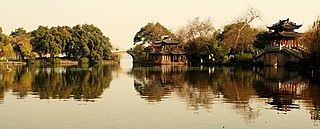
West Lake is a freshwater lake in Hangzhou, China. It is divided into five sections by three causeways. There are numerous temples, pagodas, gardens, and natural/artificial islands within the lake. Gushan (孤山) is the largest natural island and three artificial islands: Xiaoyingzhou (小瀛洲), Huixin Pavilion (湖心亭), and Ruan Gongdun (阮公墩) stand at the middle of the lake. Leifeng Pagoda (雷峰塔) and Baochu Pagoda (保俶塔) are separated by the lake. Mirroring each other, the basic pattern of "one mountain, two towers, three islands, three banks, and five lakes" is formed.

Dianchi Lake, also known as Lake Dian and Kunming Lake, is a large lake located on the Yunnan-Guizhou Plateau close to Kunming, Yunnan, China. Its nickname is the "Sparkling Pearl Embedded in a Highland" and it was the model for the Kunming Lake in the Summer Palace in Beijing. Its name is the source of Yunnan's Chinese abbreviation 滇.

Chang'an Avenue, literally "Eternal Peace Street", is a major thoroughfare in Beijing, China.
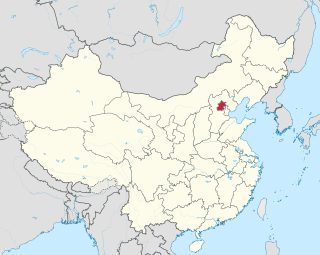
Beijing is a municipality located in North China at the northern tip of the North China Plain, near the meeting point of the Xishan and Yanshan mountain ranges. The city itself lies on flat land that opens to the east and south. The municipality's outlying districts and counties extend into the mountains that surround the city from the southwest to the northeast. The highest peaks are over 2,000 m (6,600 ft).

Jianguomen Inner Street is a major street in urban Beijing. It forms part of the extended Chang'an Avenue.

Yangzhou, postal romanization Yangchow, is a prefecture-level city in central Jiangsu Province (Suzhong), East China. Sitting on the north bank of the Yangtze, it borders the provincial capital Nanjing to the southwest, Huai'an to the north, Yancheng to the northeast, Taizhou to the east, and Zhenjiang across the river to the south. Its population was 4,414,681 at the 2010 census and its urban area is home to 2,146,980 inhabitants, including three urban districts, currently in the agglomeration.

Beihai Park is a public park and former imperial garden located in the northwestern part of the Imperial City, Beijing. First built in the 11th century, it is among the largest of all Chinese gardens and contains numerous historically important structures, palaces, and temples. Since 1925, the place has been open to the public as a park. It is also connected at its northern end to the Shichahai.
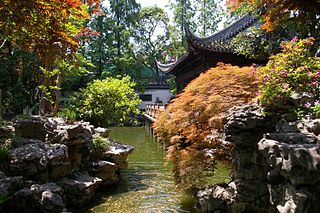
The Chinese garden is a landscape garden style which has evolved over three thousand years. It includes both the vast gardens of the Chinese emperors and members of the imperial family, built for pleasure and to impress, and the more intimate gardens created by scholars, poets, former government officials, soldiers and merchants, made for reflection and escape from the outside world. They create an idealized miniature landscape, which is meant to express the harmony that should exist between man and nature.

Lotus Pond is an artificial lake and popular tourist destination on the east side of Zuoying District in Kaohsiung, Taiwan. Opened in 1951, it is famous for the lotus plants on the lake and the numerous temples around the lake, including the Spring and Autumn Pavilions (春秋閣), the Dragon and Tiger Pagodas (龍虎塔), and the Confucian Temple (孔廟).

Houhai is a lake and its surrounding neighborhood in Xicheng District of central Beijing, China. Houhai is the largest of the three lakes, along with Qianhai 'Front Lake' and Xihai 'Western Lake', that comprise Shichahai, the collective name for the three northernmost lakes in central Beijing. Since the early 2000s, the hutong neighborhood around Houhai has become known for its nightlife as many residences along the lake shore have been converted into restaurants, bars, and cafes. The area is especially popular with foreign tourists visiting Beijing and is also often visited by the expatriate community and the younger generations of locals.
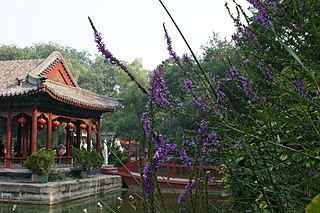
Prince Gong's Mansion, also known as the Prince Kung Mansion, is a museum and tourist attraction located in Xicheng District, Beijing, just north of the Shichahai Lake. It consists of large siheyuan-style mansions and gardens. Originally constructed for Heshen, an official highly favoured by the Qianlong Emperor, it was later renamed after Prince Gong, a Manchu prince and influential statesman of the late Qing dynasty, who inhabited the mansion in the late 19th century.
Shichahai is a historic scenic area consisting of three lakes in the north of central Beijing. They are located directly northwest of the Forbidden City and north of the Beihai Lake. Shichahai consists of the following three lakes: Qianhai (前海), Xihai (西海) and Houhai (后海). In imperial times it was called the Riverbank.

The Temple of the Earth in Beijing, China, is located in the northern part of central Beijing, around the Andingmen area and just outside Beijing's second ring road. It is also located just a few hundred yards north of Yonghe Temple. At 42.7 hectares, it is the second largest of the four Temples of Beijing behind only the Temple of Heaven.

Purple Bamboo Park is one of the seven largest parks in Beijing, China. It is located in the Haidian District of northwestern Beijing.
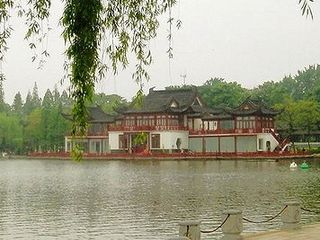
Mochou Lake is located west of the Qinhuai River and Hanzhongmen Gate in Nanjing, inside Mochou Lake Park. The lake is named after Mochou, a legendary woman known for her beauty, versatility, virtue and loyalty. It was named Hengtang in ancient times, and also known as Stone City Lake. The lake park was owned by Zhu Yuanzhang, the first emperor of Ming dynasty, and bestowed to his general Xu Da. Since then, it has become a famous garden best known for its two-storied Shenggi Pavilion. Within the park are other pavilions, gardens, pools and a stunning rock display. It is noted for its architecture, collection of carved antique rosewood furniture and calligraphies. Visitors can take boats allow through the lotus blossomed lake.
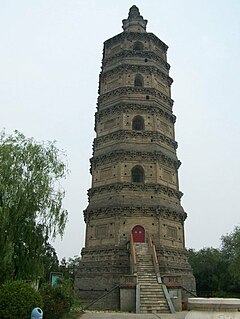
Haotian Pagoda or Liangxiang Pagoda is an octagonal brick pagoda situated in Haotian park in the Fangshan District of Beijing. It has 5 octahedral shaped hollow tiers and is 36m high. Originally constructed during Sui dynasty, the pagoda has been rebuilt a few times in the last few centuries. The brick tower standing today was built during the Liao dynasty (907–1125). In 1984 and 1997, the Beijing Municipal Administration of Cultural Heritage donated a total of over 16 million Chinese yuan for restoration works. As of September 2017 Haotian park is closed for renovations of the pagoda.

Taiye Lake or Taiye Pond was an artificial lake in imperial City, Beijing during the Jin, Yuan, Ming, and Qing dynasties of China. The beauty and utility of the lake was responsible for the siting of Kublai Khan's palace and the position of modern Beijing. It continues to exist but it is now known separately as the "North", "Central", and "South Sea"s, the three interconnected lakes just west of the Forbidden City in downtown Beijing. The northern lake makes up the public Beihai Park while the southern two are grouped together as Zhongnanhai, the headquarters for the Communist leadership of the People's Republic of China.
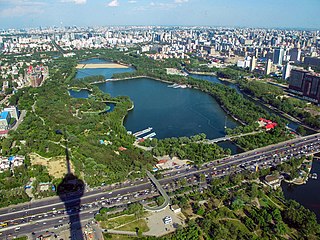
Yuyuantan Park is one of major urban parks in the city of Beijing. This park covers a territory of about 137 hectares, 61 of which are covered by water. Yuyuantan is the largest water body in the park, and it literally means the Jade Deep Pond. The park is located between the western segment of the Third Ring Road and Diaoyutai State Guesthouse. The China Millennium Monument is located just to the south of the park, and the Chinese Navy Hospital is to the north of the park. Central Radio & TV Tower can be viewed in the park.

Longtan Lake Park, is a recreational urban park located in Dongcheng District of Beijing, just east of the Temple of Heaven. It is one of the largest modern parks inside the 2nd Ring Road of Beijing. There is also a large outdoor bird market in the park. Located at the center of the park is a large lake called which features many moon bridges, rock gardens, dragon boats, tea houses and restaurants. '
Yaowa Lake Park is a major public urban park in eastern Beijing. It is the only public comprehensive park in Nanmofang region of Beijing. The 4th Ring Road of Beijing cuts through the park and divides it into two halves. The Yaowa Lake is in the eastern half of the park. In Qing Dynasty, people grubbed mud in eastern Beijing to make bricks. Two big caves are created near today's Huagong Road. Then, rain water impounded in these two caves and made them two lakes. The northern lake later became the cooling pond of Beijing Thermal Power Plant, and the southern lake was named as Yaowa Lake, and later preserved to be the public park.




















